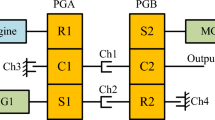Abstract
Variable driving conditions can cause an integrated starter generator hybrid powertrain to switch between multiple drive modes. The addition of a permanent magnet synchronous motor (PMSM) gives hybrid powertrains complex electromechanical coupling characteristics. The effects of excitation sources, such as the engine and PMSM, may cause unstable behavior in the drive system, such as speed fluctuations during mode switches due to electromechanical coupling characteristics. Although traditional mode switch strategies and methods have achieved measurable results, they are difficult to improve. To solve this problem, we first considered the combination and separation of the clutch and establish a nonlinear model of mode switches for series–parallel hybrid electric vehicles. Then, we predicted the instability boundary of the drive system during mode switches. Experimental results indicated that the proposed instability boundary has higher accuracy. Numerical results showed that the three-mode switches have different thresholds of instability for the clutch structure gap. The decrease in electromagnetic torque and the increase in load excitation amplitude will improve the critical value of the clutch structure gap. The increase in load excitation frequency causes the critical value of the clutch structure gap to drop first and then rise.












Similar content being viewed by others
References
Karaoğlan, M.U., Kuralay, N.S., Colpan, C.O.: The effect of gear ratios on the exhaust emissions and fuel consumption of a parallel hybrid vehicle powertrain. J. Clean. Prod. 210, 1033–1041 (2019)
Khorashadizadeh, S., Sadeghijaleh, M.: Adaptive fuzzy tracking control of robot manipulators actuated by permanent magnet synchronous motors. Comput. Electr. Eng. 72, 100–111 (2018)
Ortega, R., Monshizadeh, N., Monshizadeh, P., Bazylev, D., & Pyrkin, A.: Permanent magnet synchronous motors are globally asymptotically stabilizable with PI current control. (2018). arXiv preprint http://arxiv.org/abs/1806.01419
Yu, P., Zhang, T., Liu, P.H.: Mechanical and electrical coupling vibration characteristic analysis of power train system for electric driven vehicle. In: Applied Mechanics and Materials. vol. 224, pp. 385–388. Trans Tech Publications (2012)
Tseng, C.Y., Yu, C.H.: Advanced shifting control of synchronizer mechanisms for clutchless automatic manual transmission in an electric vehicle. Mech. Mach. Theory 84, 37–56 (2015)
Zhao, Z., Lei, D., Chen, J., Li, H.: Optimal control of mode transition for four-wheel-drive hybrid electric vehicle with dry dual-clutch transmission. Mech. Syst. Signal Process. 105, 68–89 (2018)
Zang, H.G., Niu, Y.X., Han, Y.L.: Coordinated control of speed during driving mode switches for parallel hybrid electric vehicles. In: Advanced Materials Research, vol. 468, pp. 107–110. Trans Tech Publications (2012)
Yang, Y., Huang, J.F., Qin, D.T., Yang, W.H.: Coordinated torque control for mode switch between motor and engine driving in heavy hybrid electric vehicle. In: Applied Mechanics and Materials, vol. 86, pp. 779–783. Trans Tech Publications (2011)
Zeng, Y., Huang, Z., Cai, Y., Liu, Y., Xiao, Y., Shang, Y.: A control strategy for driving mode switches of plug-in hybrid electric vehicles. Sustainability 10(11), 4237 (2018)
Lin, Y., Qin, D., Liu, Y., Yang, Y.: Control strategy for all the mode-switches of hybrid electric vehicle. Adv. Mech. Eng. 8(11), 1687814016681233 (2016)
Xiang, C., Huang, K, Ma, Y., et al.: Stability analysis for mode switch of multi-mode electro-mechanical transmission (EMT). In: 2014 IEEE Transportation Electrification Conference and Expo, Asia-Pacific (ITEC Asia-Pacific). IEEE (2014)
Minh, V.T., Rashid, A.A.: Modeling and model predictive control for hybrid electric vehicles. Int. J. Automot. Technol. 13(3), 477–485 (2012)
Mendes, A.S., Meirelles, P.S.: Application of the hardware-in-the-loop technique to an elastomeric torsional vibration damper. SAE Int. J. Engines 6(4), 2004–2014 (2013)
Mendes, A.S., Meirelles, P.S., Zampieri, D.E.: Analysis of torsional vibration in internal combustion engines: modelling and experimental validation. Proc. Inst. Mech. Eng. Part K J. Multi-body Dyn. 222(k2), 155–178 (2008)
Yu, Y., Mi, Z.: Dynamic modeling and control of electromechanical coupling for mechanical elastic energy storage system. J. Appl. Math. 2013 (2013)
Chen, X., Yuan, S., Peng, Z.: Nonlinear vibration for PMSM used in HEV considering mechanical and magnetic coupling effects. Nonlinear Dyn. 80(1–2), 541–552 (2015)
Li, L., Wang, X., Xiong, R., et al.: AMT downshifting strategy design of HEV during regenerative braking process for energy conservation. Appl. Energy 183, 914–925 (2016)
Xiang, C., Liu, F., Liu, H., Han, L., Zhang, X.: Nonlinear dynamic behaviors of permanent magnet synchronous motors in electric vehicles caused by unbalanced magnetic pull. J. Sound Vib. 371, 277–294 (2016)
Jiang, Y., Sun, J.: Si’Inikov homoclinic orbits in a new chaotic system. Chaos Solitons Fractals 32(1), 150–159 (2007)
Baldom, I., Seara, T.M.: Breakdown of heteroclinic orbits for some analytic unfoldings of the Hopf-zero singularity. J. Nonlinear Sci. 16(6), 543–582 (2006)
Acknowledgements
This work was supported by the Science Fund of the State Key Laboratory of Automotive Safety and Energy (Grant No. KF2023), the State Key Laboratory of Automotive Simulation and Control (Grant No. 20191103) and the National Natural Science Foundation of China (Grant No. 51705208).
Author information
Authors and Affiliations
Corresponding authors
Ethics declarations
Conflict of interest
The authors declare that there is no conflict of interest regarding the publication of this paper.
Additional information
Publisher's Note
Springer Nature remains neutral with regard to jurisdictional claims in published maps and institutional affiliations.
Rights and permissions
About this article
Cite this article
Hu, D., Zhang, J., Hu, L. et al. Dynamic characteristic analysis for clutch engagement process of series–parallel hybrid electric vehicle. Nonlinear Dyn 105, 45–59 (2021). https://doi.org/10.1007/s11071-021-06609-7
Received:
Accepted:
Published:
Issue Date:
DOI: https://doi.org/10.1007/s11071-021-06609-7



